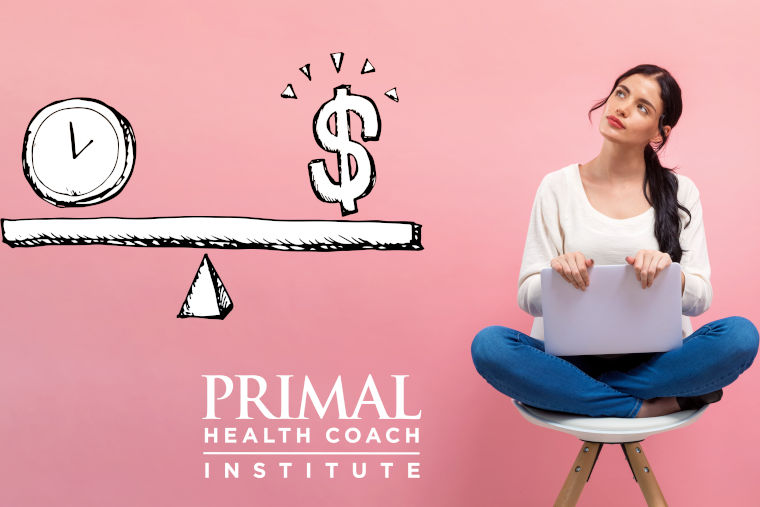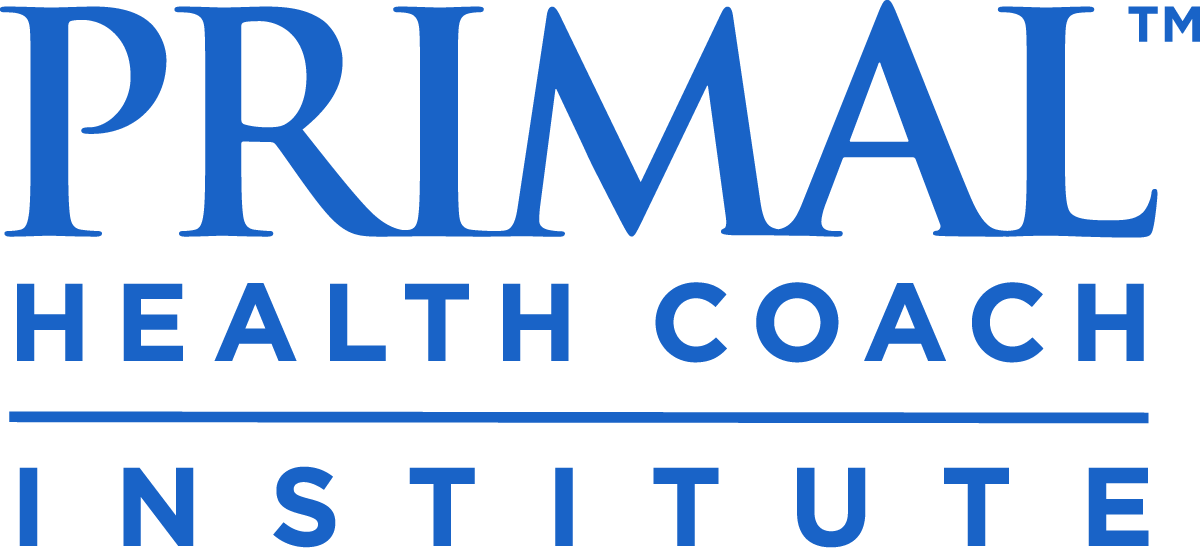
It feels like a big decision to set prices as a new health coach, but rest assured knowing that your services and prices can and will change, many times, over the years.
Here are 5 overarching questions to help determine how much to charge for your health coaching services:
1. What kind of services do you offer?
When you’re first starting out, it’s wise to work with 1-on-1 clients because you’ll learn so much in the process. It’s also a simpler, flexible business model to manage in your first few years of business.
Regardless, there are many different ways to package your services…
- Will you offer monthly 1-on-1 packages or a three-month program?
- Will you meet for weekly sessions, bi-weekly or monthly?
- How long will the coaching sessions be?
- Are you offering *a-la-carte services or will everything be included?
*A-la-carte services might include a pantry overhaul or a personalized fitness plan, for instance.
It’s a good idea to offer packages at a minimum of three months because health coaches influence the most change over the long term.
Three-month goals are great for coach and client because they allow enough time to make meaningful progress, build new habits, experience setbacks and feel the benefits. It’s also short enough to feel the urgency of a finish line.
Our Primal Health Coach Institute graduates receive a turn-key coaching program designed to coach individual clients and group challenges with a proven protocol. That serves as a great starting point from which to eventually expand one’s services. Many coaches lead wellness workshops, host health/fitness retreats, or develop an online program that targets a niche market.
Keep the number of offerings at three or fewer so your prospects aren’t overwhelmed with options, and so you can focus your efforts.
2. How much time are you trading for money?
“Time is your only non-renewable resource and you must be paid for it,” says veteran health coach and PHCI mentor, Laura Rupsis.
Resist the urge to underprice your services because you’re less experienced. You should be paid fairly for your time and services, and to a client who is struggling, your knowledge and support are very valuable.
“Certain services allow you to leverage that time more efficiently than others,” says Laura. For example, your individual program should be priced higher than a group program because of the time you devote to customizing it to one person.”
Groups can still require more time because there are so many moving parts—like the time it takes to promote, launch, and onboard enough clients to build a group. Generally, a small group program might be priced at half the rate of your 1-on-1 program so that you have the potential to make twice as much money with four clients in a group, versus one client you coach privately.
“Think in terms of scalability as well. A short program that’s repeatable over and over again should be priced less than a more involved program with more customization or personal interaction.” – Laura Rupsis
Keep in mind you aren’t just charging for the hour spent in coaching sessions. Included in the fee is the time it takes for check-ins between sessions (if offered), time to do research or provide educational resources, as well as your overhead fees for business software or tools, payment fees and taxes.
3. What are your personal income goals or needs?
What are your income goals? Write down how much you’d like to make per month, and then estimate how much you’d need to make each month, over the span of 12 months (if you gradually sold more services each month you’re in business).
Let’s say your optimal goal is $4,000 USD per month. Here’s a possible projection of the gradual income you can strive for over 12 months:
Months 1-3: $300 per month
Months 4-5: $600 per month
Months 6-7: $900-$1,200 per month
Months 8-10: $1,500-$2,600 per month
Months 11-12: $3,200-$4,000 per month
This example may be ambitious for new coaches, yet, in some cases, your prior experience may prove useful and accelerate this new business endeavor. Most health coaches can expect to generate income that’s aligned with their goals after about 2-3 years of consistent effort in building the business.
Once you have an income goal, think about the following:
- How many services would you need to sell and at what price?
- How many clients can you realistically take on at one time?
- How will you continue to attract new clients while managing an active client roster?
Work out a basic, fluid goal for yourself and be realistic. It would be a challenge for most newbies to attract new clients while managing a roster of 10 individual clients, for example. Mentor Laura Rupsis suggests that rotating in some short challenges or groups may prove more successful early on, especially for coaches who have built a niche following or viable offer.
On average, clients expect to pay around $1,000 USD, total, for 3-4 months of health coaching. “You can transition into your health coaching business part-time with just a few clients on the side, earning $1,000 a month with ease, gradually increasing to 10+ clients over time to earn a financially fulfilling living as a Primal Health Coach,” says PHCI mentor Christine Hassler.
4. Do you have any additional qualifications?
As a Primal Health Coach, you’ve already established yourself as an expert in a niche market that stands apart from other coaches. Do you have any other degrees, licenses, or certifications that further increase the value of your services? If so, this should be taken into consideration as you might decide to charge more for your expertise.
5. What, if any, economic factors concern you or your ideal client?
- If you attract clients from a particular geographical area, how’s the economy of that location?
- Considering your ideal client (ICA), what’s their income like? Do they have a credit card, expendable income, or savings?
- Has your ICA paid for out-of-pocket services like a personal trainer, massage therapist, or business coach?
- Do you prefer that clients pay in full? Will your ICA be willing to pay in full or do they need a payment plan?
If you’d like to work with varied budgets, consider creating a tiered approach for your offerings. For clients with a more limited budget, you might have a self-guided version of your coaching program that’s more automated—like PHCI instructor Erin Power did with her 8 Weeks to Effortless program for $119 CAD.
Coach Laura Rupsis has allowed people the option “to sign on with a friend so they share the price of the program. Instead of someone paying $1,200 for a 12-week program, two friends will pay $800 each and save.”
Real-World Examples
When considering what to charge as a health coach, you can use personal trainer rates as a starting point. Personal trainers charge anywhere from $60-150 or more per hour—depending on where they live, if they work solo or under a particular company, their experience/certifications, facilities, etc. Although much of the work we do as coaches is not easily translated to an hourly rate, this gives us a good baseline to compare to.
Check out the packages and pricing from some of our working PHCI graduates:
- Sarah from Catalyst Wellness Coaching: $400 online course, $200+ a la carte services, 1-on-1 coaching for $500/month
- Christopher from Ketology: 1-on-1 coaching for $497/month, group membership for $97/month
- Shana from Primal Phire Wellness: $99 group program, $700 1-on-1 package, and a-la-carte starting at $70
- Gabriel from Fuel Your Life: 12-week program for $1,199, 28-Day program for $199
- Janiece from Simple Sustenance: 1-on-1 package for $950
- Mindy from Morris Natural Health: subscription for $7.99/month, challenges under $50, 1-on-1 coaching for $199-$399/month
- Coach Stacey Portugal: Self-guided program for $147 and a group program for $197/month
- Joe from Primal Example: 20 Pounds in 20 Days program for $100
- Amy Rosner, PhD: Clinical Hypnotherapy for $150/month to $200/session
So many things to consider! We know. Start small, and start now. You’ll be glad you didn’t hesitate any longer.



